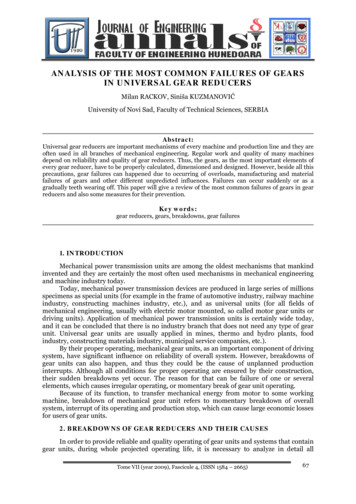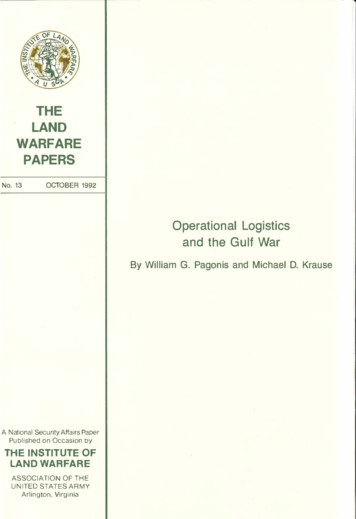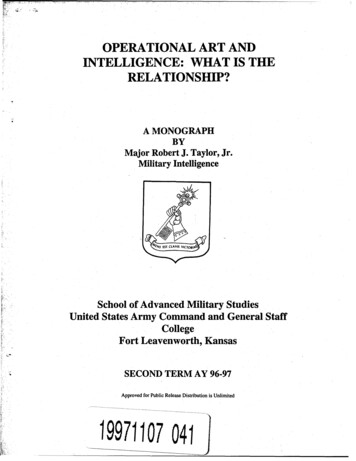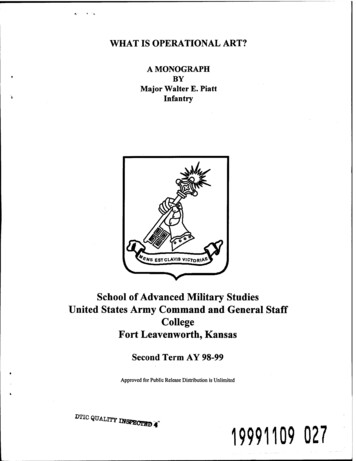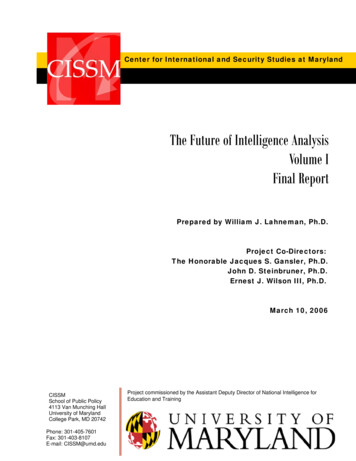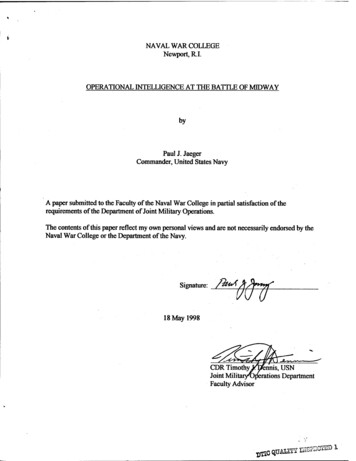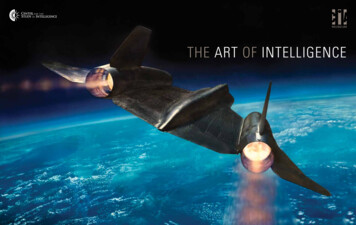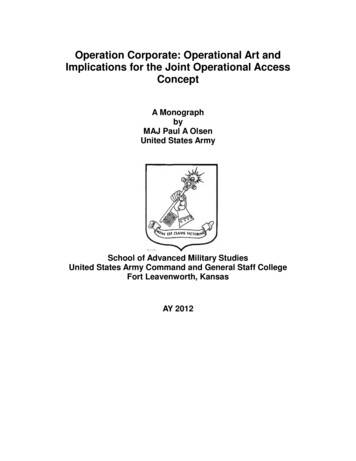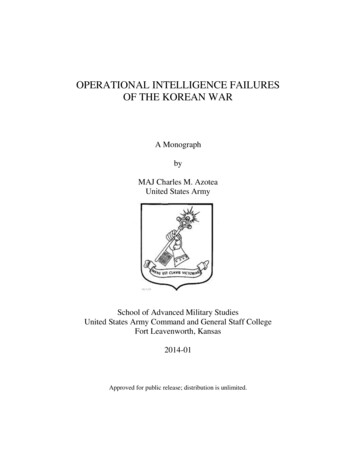
Transcription
OPERATIONAL INTELLIGENCE FAILURESOF THE KOREAN WARA MonographbyMAJ Charles M. AzoteaUnited States ArmySchool of Advanced Military StudiesUnited States Army Command and General Staff CollegeFort Leavenworth, Kansas2014-01Approved for public release; distribution is unlimited.
REPORT DOCUMENTATION PAGEForm ApprovedOMB No. 0704-0188Public reporting burden for this collection of information is estimated to average 1 hour per response, including the time for reviewing instructions, searching existing data sources, gathering and maintaining thedata needed, and completing and reviewing this collection of information. Send comments regarding this burden estimate or any other aspect of this collection of information, including suggestions for reducingthis burden to Department of Defense, Washington Headquarters Services, Directorate for Information Operations and Reports (0704-0188), 1215 Jefferson Davis Highway, Suite 1204, Arlington, VA 222024302. Respondents should be aware that notwithstanding any other provision of law, no person shall be subject to any penalty for failing to comply with a collection of information if it does not display a currentlyvalid OMB control number. PLEASE DO NOT RETURN YOUR FORM TO THE ABOVE ADDRESS.1. REPORT DATE (DD-MM-YYYY)2. REPORT TYPE22 MAY 2014Master’s Thesis3. DATES COVERED (From - To)JUN 2013-MAY 20144. TITLE AND SUBTITLE5a. CONTRACT NUMBEROperational Intelligence Failures of the Korean war5b. GRANT NUMBER5c. PROGRAM ELEMENT NUMBER6. AUTHOR(S)5d. PROJECT NUMBERMajor Charles M. Azotea, U.S. Army5e. TASK NUMBER5f. WORK UNIT NUMBER7. PERFORMING ORGANIZATION NAME(S) AND ADDRESS(ES)8. PERFORMING ORGANIZATION REPORTNUMBERSchool of Advanced Military Studies201 Reynolds AvenueFt. Leavenworth, KS 6602710. SPONSOR/MONITOR’S ACRONYM(S)9. SPONSORING / MONITORING AGENCY NAME(S) AND ADDRESS(ES)U.S. Army Command and General Staff CollegeATTN: ATZL-SWD-GDFort Leavenworth, KS 66027-230111. SPONSOR/MONITOR’S REPORTNUMBER(S)12. DISTRIBUTION / AVAILABILITY STATEMENTApproved for Public Release; Distribution Unlimited13. SUPPLEMENTARY NOTES14. ABSTRACTThis monograph addresses the failures of United States military operational intelligence regarding the invasion of South Korea by theNorth Korean Peoples’ Army and the subsequent intervention by the Chinese Communist forces. These operational intelligence failureswere a result of post-World War II policies that reduced the size of the military, cut systems and training, and reorganized intelligenceservices responsible for those failures.Reorganization of intelligence structures and training cutbacks produced ineffectual intelligence soldiers deployed to Far East Commandand Korea. Personnel shortages in intelligence analysis, communications, signals and photographic intelligence, and linguistics furtherreduced intelligence collection and production. Poorly trained analysts, were unable to determine North Korean and Chinese intentions atboth the strategic and operational level, which contributed to poor predictive analysis. United States strategic policy’s focus on the threatposed by the Soviet Union to Western Europe further exacerbated intelligence failures in the Far East.General MacArthur’s assessments, as Far East Commander and Commander of United Nations Forces in Korea, proved decisive inshaping political and military strategies. Major General Willoughby, MacArthur’s senior intelligence officer (G-2), shared MacArthur’sviews and propagated them throughout the intelligence communities of both the Far East Command and Washington, DC. Analysts at alllevels underestimated the Peoples’ Republic of China, largely as a result of cultural bias and a lack of understanding of Chineseoperational art and tactics.Operational intelligence failures, created by post-World War II policies, led to poor readiness and lack of capability. This operationalunpreparedness produced an inability to determine appropriate indicators and warnings of both North Korean and Chinese intentions. Theresults of these failures carry on to this day more than 60 years later.15. SUBJECT TERMSKorean War, Military Intelligence, Intelligence Failure16. SECURITY CLASSIFICATION OF:17. LIMITATIONOF ABSTRACTa. REPORTb. ABSTRACTc. THIS PAGE(U)(U)(U)18. NUMBEROF PAGES19a. NAME OF RESPONSIBLE PERSON19b. TELEPHONE NUMBER (include area code)(U)79Standard Form 298 (Rev. 8-98)Prescribed by ANSI Std. Z39.18
MONOGRAPH APPROVAL PAGEName of Candidate: MAJ Charles M. AzoteaMonograph Title:Operational Intelligence Failures of the Korean WarApproved by:, Monograph DirectorJeffrey J. Kubiak, Ph.D., Seminar LeaderUwe F. Jansohn, COL, Director, School of Advanced Military StudiesHenry A. Arnold III, COLAccepted this 22nd day of May 2013 by:, Director, Graduate Degree ProgramsRobert F. Baumann, Ph.D.The opinions and conclusions expressed herein are those of the student author and do notnecessarily represent the views of the U.S. Army Command and General Staff College or anyother governmental agency. (References to this study should include the foregoing statement.)ii
ABSTRACTOPERATIONAL INTELLIGENCE FAILURES OF THE KOREAN WAR, by MAJ Charles M.Azotea, 79 pages.This monograph addresses the failures of United States military operational intelligence regardingthe invasion of South Korea by the North Korean Peoples’ Army and the subsequent interventionby the Chinese Communist forces. These operational intelligence failures were a result of postWorld War II policies that reduced the size of the military, cut systems and training, andreorganized intelligence services responsible for those failures.Reorganization of intelligence structures and training cutbacks produced ineffectual intelligencesoldiers deployed to Far East Command and Korea. Personnel shortages in intelligence analysis,communications, signals and photographic intelligence, and linguistics further reducedintelligence collection and production. Poorly trained analysts, were unable to determine NorthKorean and Chinese intentions at both the strategic and operational level, which contributed topoor predictive analysis. United States strategic policy’s focus on the threat posed by the SovietUnion to Western Europe further exacerbated intelligence failures in the Far East.General MacArthur’s assessments, as Far East Commander and Commander of United NationsForces in Korea, proved decisive in shaping political and military strategies. Major GeneralWilloughby, MacArthur’s senior intelligence officer (G-2), shared MacArthur’s views andpropagated them throughout the intelligence communities of both the Far East Command andWashington, DC. Analysts at all levels underestimated the Peoples’ Republic of China, largely asa result of cultural bias and a lack of understanding of Chinese operational art and tactics.Operational intelligence failures, created by post-World War II policies, led to poor readiness andlack of capability. This operational unpreparedness produced an inability to determine appropriateindicators and warnings of both North Korean and Chinese intentions. The results of thesefailures carry on to this day more than 60 years later.iii
ACKNOWLEDGMENTSI would like to thank the Almighty for the gifts He has bestowed upon me. First, I wouldlike to thank my wife, Franch’ette for all her love and support. I am unable to express how muchshe means to me. Second, I would like to thank my son, Charles, who motivates me to be a betterDad and man. Next, I would like to thank my mother and father, for their guidance and direction,and their love. Lastly, I would like to thank all the people who have helped me in my endeavors.They, and all their hard work and efforts on my behalf, are well remembered.iv
TABLE OF CONTENTSACRONYMS .viINTRODUCTION . 1THE ROLE OF INTELLIGENCE . 3THE ROAD TO FAILURE . 5THE NORTH KOREAN INVASION. 12THE CHINESE COMMUNISTS’ INTERVENTION . 34MACARTHUR AND WILLOUGHBY . 52CONCLUSION . 59BIBLIOGRAPHY . 66v
ACRONYMSAFSAArmed Forces Security Agencyvi
INTRODUCTIONThe United States, since its inception as a nation, has reduced the size of its militaryservices at the conclusion of its wars. This tendency has myriad motives, yet the primary, andprevalent argument is the financial rewards reaped from such actions. Post-conflict, the stockrefrain is one of cashing in on a peace dividend. Politicians are very aware of the benefits derivedfrom ensuring the American public that tax reductions will follow in the wake of militarydownsizing. Military downsizing comes at a cost though. War’s exorbitant costs are heightenedby higher casualty rates as military personnel relearn the ways of war and the requirementsneeded to refurbish dilapidated combat forces.Military intelligence failures regarding the 1950 invasion of South Korea by the NorthKorean Peoples’ Army and the subsequent intervention by Chinese Communist Forces resultedfrom post-World War II executive and Department of Defense policies. The reduction inpersonnel, training, and combat systems was further exacerbated by the strategic policy focusingon the Soviet Union and placing Korea outside of the United States defense perimeter. Lastly,intelligence analysts’ training focused on enemy order of battle and capabilities instead ofintentions and objectives. This produced an inability to determine North Korean and Chinesecapabilities and intentions. These intelligence failures were a conglomeration of United Statesstrategic political and military policy failures.Reductions in personnel, systems, and financial resources, compounded by the confusionengendered by the same rapid reductions and reorganizations, impeded the military’s intelligenceservices’ ability to adequately prepare its intelligence personnel. Second, post-war reorganizationfailed to create a distinctive military intelligence branch, especially for the Army. This failurehindered efforts to regulate and professionalize military intelligence soldiers. Third, analystassignment and training was in constant flux and universally sporadic throughout all theintelligence specialties. Force reductions hampered military intelligence efforts, and drove1
reassignment of urgent missions with the limited resources available. Numerous threat regionslacked the requisite intelligence coverage and analysis due to these retrenchments. At the end ofthe 1940s, the military intelligence community failed to provide its political and militaryleadership the necessary indications and warnings of regional threats pertaining to United States’strategic and operational interests in the Far East.This study posits that post-World War II, Department of Defense, and service branchpolicies further exacerbated by national strategic policy, negatively impacted military intelligencepersonnel, training, systems availability, and readiness. As a result, operational intelligence failedto provide the proper indications and warnings of the invasion of South Korea by the NorthKorean People’s Army and the subsequent intervention by Chinese Communist Forces.The purpose of this project is to identify the causes of operational intelligence failuresduring the Korean War. This paper’s hypothesis is that these failures were due to post-World WarII political decisions, as well as the military service branches’ strategic and operational decisions.The argument starts with an examination of the role of intelligence doctrine during and postWorld War II, and its evolution from 1949 to 1951. Next, the devolution of operationalintelligence at the end of World War II until the Korean War is examined. Third, operationalintelligence failures as they pertain to the North Korean invasion and subsequent ChineseIntervention are discussed. Finally, the negative impact General MacArthur and his seniorintelligence officer, Major General Willoughby, had on operational intelligence is highlighted.The budget sequester of March 2013, threatens to repeat the trend and consequences ofbudget cuts that followed World War II.1 The Defense Department has already initiatedsignificant cuts which would yield the smallest ground force since 1940, the smallest number ofThe White House, “What You Need to Know About the Sequester,” quester (accessed March 22, 2014).12
ships since 1915, and the smallest Air Force in United States history.2 Former Defense SecretaryLeon Panetta explained that “war efforts would be adversely affected by the severe disruption inthe base budgets . . . the threats to national security would not be reduced.”3It is unclear what these defense cuts mean for the various service branches. What will theimpacts be on readiness, training, systems, and research and design? Another looming issue is theinevitable competition between the services as monies and resources dwindle in a time of fiscalausterity. As the services shrink, what is the impact to the institutional knowledge of servicemembers that remain in the ranks? This is most alarming in light of the ongoing crisis in Syria,Sino-Japanese relations over the Senkaku/Diaoyu islands, a possible cyberattack on criticalUnited States infrastructure, and the burgeoning Ukrainian-Russian confrontation. Willoperational intelligence become a vulnerability over the next decade?Respectable portions of the American people are tired after more than a decade of war.Myriad similarities exist between the post-World War II and post-Overseas ContingencyOperations eras. Examining the causes of intelligence failures prior to, and during, the KoreanWar allows for some insight into the potential impacts of similar circumstances. Budgetaryconstraints, force reductions, government restructuring, and interservice rivalry must be mitigatedto prevent intelligence failures in the next conventional or unconventional conflict in which theUnited States engages.THE ROLE OF INTELLIGENCEIntelligence doctrine states that intelligence functions to support commanders and theirstaffs by providing situational understanding of threats, the effects of terrain and weather on2Leon Panetta, Letter to Senators John McCain and Lindsey Graham, U.S. Congress, House,Armed Services Committee, ve?File id 9692f972-eb8646da-bc8d-ff4d461e6c00 (accessed March 22, 2014).3Ibid.3
personnel and systems, and civilian considerations.4 Field Manual (FM) 100-5, Field ServiceRegulations - Operations (August 1949), explains that the “gathering of information and theproduction of intelligence must be based not only upon our own plans and intentions but alsoupon a consideration of enemy capabilities.”5 It also states that the essential elements ofinformation describe “what is the strength, composition, and disposition of the enemy; whatcourses of action that can affect our mission are within the physical capabilities of the enemy;when and under what circumstances can he put each course of action into effect; and whether,when, and in what strength, can he be reinforced?”6The regulation explains that enemy intelligence is deduced from numerous indications ofthe enemy’s activities, collected by organic reconnaissance and other agencies. It goes on toinform the commander that any combat unit under his command serves as an informationcollection agency, with primary focus placed on ground and air units for reconnaissance andobservation. Additional agencies include Air Force and Naval elements operating in support of,or with the commander. Assigned or attached intelligence personnel, and intelligence elementsliaison with the headquarters of higher, lower, or adjacent units. Finally, it informs thecommander that the Department of the Army provides the principal sources of intelligence tofield forces prior to operations.7In 1951, new intelligence doctrine was released in Field Manual (FM) 30-5, CombatIntelligence, covering strategic intelligence and combat intelligence. These two forms of4Headquarters, Department of the Army, Army Doctrine Reference Publication 2-0, Intelligence(Washington, DC: Government Printing Office, 2012), 2-1.5Headquarters, Department of the Army, Field Service Regulations 100-5, Operations(Washington, DC: Government printing Office, 1949), 34-37.6Ibid.7Ibid., 36.4
intelligence are concerned with the military significance of foreign powers and covered the areasof actual or possible operations. FM 30-5 further stated that, “many of the subjects of interest tocombat intelligence and strategic intelligence are closely related. In some instances, they areidentical.”8 FM 30-5 divided intelligence production into four steps: the collection of information,it’s processing to produce intelligence, using the resultant intelligence, and directing theintelligence effort.9With FM 30-5, we see another evolution of intelligence doctrine, which is closer totoday’s doctrine than FM 100-5 (1949). When FM 30-5 was published, the Korean War was astalemate, which continued until the signing of the armistice in 1953.10 Delving further into FM30-5, one sees the impact of the Korean War on the development of intelligence doctrine.Intelligence doctrine, drawn from FM 100-5, was largely based on experiences fromWorld War II and was not designed for limited war. It mixed strategic and tactical intelligence.The publishing of FM-30-5 was due to issues that came about during the course of the KoreanWar.THE ROAD TO FAILUREDuring World War II the various services supported their combat forces by developingsignificant intelligence capabilities. Army intelligence, operating under the auspices of theMilitary Intelligence Service conducted collection missions the world over. These includedhuman intelligence, communications and signals intelligence interception, and photographicreconnaissance. The Military Intelligence Service provided intelligence analysis to United Statesand Allied commands. Concurrently, intelligence elements were assigned in direct support of8Headquarters, Department of the Army, Field Service Manual 30-5, Combat Intelligence(Washington, DC: Government Printing Office, 1951), 3-6.9Ibid., 23.10Ibid., 3-6 and 23.5
tactical field forces. The Army Air Corps conducted aerial reconnaissance, while the ArmyCounterintelligence Corps, created in 1942, provided human intelligence support both statesideand overseas. Army signals analysts broke and exploited Imperial Japanese Army codes andprovided support to the ULTRA mission, which came from the decoding of German Enigmacipher machines.In the Pacific theater, the Navy’s intelligence unit began work deciphering the JapaneseFleet code, JN25. This effort paid dividends at the Battle of the Coral Sea, April 1942, with theJN25 code completely deciphered by May 1942. This assisted in the defeat of the Japanese at theBattle of Midway and provided countermeasures against Japanese efforts for the war’s duration.Army human intelligence efforts created the Allied Translator and Interpreter Section, AmericanNisei soldiers, who exploited captured Japanese prisoners and documents. Another effortconsisted of the Alamo Scouts, comprised of long distance reconnaissance teams, and Australianand Filipino guerilla forces. The Marines created and deployed the Navajo Code Talker Programin May 1942. By 1945, Navajo Wind Talkers were operating in both the Pacific and Europeantheaters.11The United States and Allied commanders commended the intelligence support providedthem during World War II by numerous organizations and systems. What occurred to the UnitedStates military intelligence structure in the five years between World War II and the Korean War?What caused such a severe degradation of military intelligence capabilities and capacities?At the conclusion of the war, American defense policy became centered on nuclearweapons as a deterrent to war due to the emergence of the Cold War. Nuclear deterrence policybrushed aside the prospects of nuclear parity or regional conflicts requiring a military responseCommission on the Roles and Capabilities of the United States Intelligence Community, “TheEvolution of the U.S. Intelligence Community – A Historical Overview,” March 1, 1996, Federation ofAmerican Scientists, http://www.fas.org/irp/offdocs/int022.html (accessed March 22, 2014).116
that would be less than total devastation. The Soviet Union’s detonation of a nuclear weapon in1949 ended American nuclear hegemony, which surprisingly did not alter American policy. TheUnited States failed to modernize its conventional military forces, with the Air Force being thesole exception.12At the conclusion of World War II in the Pacific, the United States armed forcesnumbered over 12 million men and women. The Army began its force drawdown of about 8.3million soldiers in May 1945.13 President Truman stated in August 1945 that the Army wouldrelease five to five-and-a-half million men.14 This reduction occurred within 12 to 18 months.Major General Stephen Henry, Army Deputy Chief of Staff, testified to the House ofRepresentatives, that the Army planned to reduce the force by six-and-a-half million men withinone year. Surprisingly, Henry’s testimony also occurred in August of 1945, shortly after PresidentTruman’s statement.By the end of 1948 the Army had whittled its forces down to 554,000, approximatelyone-sixteenth of its earlier size.15 Political concerns enabled the rapid reduction of the military.This force reduction was neither measured nor balanced and ignored requirements outlined inregional threat assessments as well as requirements to respond to exigencies. This injudiciousdrawdown of men, materiel, and capabilities precipitated a major shift in the United Statesdefense policy.12Adrian R. Lewis, The American Culture of War, 2nd Ed. (New York: Routledge, 2012), 72. Apresidential Air Policy Commission, set up in 1947, embraced the possibilities that air power promised.They advocated the importance of airpower. The final report put forth by the commission emphasized thetheory of massive retaliation, the need to reject former methods of the conduct of war, and sustainedreadiness. Lastly, the commission concluded that ground combat was a thing of the past.13John C. Sparrow, History of Personnel Demobilization in the United States Army (New York:the Free Press, 1984), 21.14David McCormick, The Downsized Warrior (New York: New York University Press, 1998), 10.15Ibid.7
The drawdown cast the die and the Army rapidly withered on the vine during thesubsequent years. As an organization, the Army garnered minimal attention and monies,maintaining the lowest personnel levels possible.16 From 1945 to 1950, the Army also sufferedcutbacks in training and materiel authorizations. In 1948, budget cutbacks reduced basic trainingfrom 14 to eight weeks.17 Furthermore, the post-World War II Army relied on stockpiles ofmateriel and equipment from World War I. Budget cuts hampered the procurement of modernequipment and research and development of state-of-the-art equipment. The United Statesgovernment and the Army discarded the lessons learned post-World War I downsizing.Lieutenant General Ridgeway, commander of the Eighth Army in Korea during the war stated itbest; “We were, in short, in a state of shameful unreadiness.”18 By 1950, the Army was a shadowof its former self. Serving as an occupation force around the world, but primarily in Europe, thepreponderance of overseas units remained undermanned, insufficiently trained and equipped, andunprepared for the coming conflict.From 1945 to 1950, the United States changed radically, both militarily and politically,while global events reshaped the Allies’ vision of the world order post-World War II. PresidentTruman’s “actions during the events that took place laid the foundation not only for United Statesforeign and military policies but also for the structure of world politics, and war in the latter halfof the twentieth century.”19 He saw the end of World War II and the inception of the Cold War,which ended in 1990. He also advocated the policy of containment, which became the major16McCormick, 73.Roy K. Flint, “Task Force Smith and the 24th Division: Delay and Withdrawal, 5-19 July 1950,”in America’s First Battles, 1775-1965, eds. Charles E. Heller and William A. Stofft (Lawrence, KS:University of Kansas, 1986), 269.1718Clay Blair, The Forgotten War: America in Korea, 1950-1953 (New York: First Anchor Books,1989), 271.19Lewis, 66.8
United States policy designed to deter the spread of communism. According to historianLawrence Freedman, “Throughout the cold war the concept of deterrence was central to allstrategic discourse. Every strategic move of the West was made with reference to itsrequirements.”20 This policy responded to a number of stratagems employed by the Soviet Unionto enlarge communist influence in Eastern Europe, China, and Korea. In 1945, President Trumantold the American people in a “Special Message to Congress:”In short, we must be prepared to maintain in constant and immediate readinesssufficient military strength to convince any future potential aggressor that this nation, inits determination for a lasting peace, means business.21While President Truman accepted the new role and responsibilities now required of theUnited States, he failed to truly understand the enormity of the task that lay before him. Hisadministration’s foreign policy concentrated on the containment of the Soviet Communist threat.The United States remained predisposed to containing the spread of Communism, communistdoctrine, and communist influence globally. The Iron Curtain divided Germany and all of EasternEurope fell into Soviet hegemony by 1946. The situation in the Far East was not much better. In1949, Chinese Communist forces, led by Mao Zedong, forced Chiang Kai-shek’s Nationalistgovernment to flee to Formosa, known later as Taiwan, as China fell under Communist rule. TheRepublican Party mocked Truman’s administration for having lost China by not adequatelysupporting Chiang Kai-shek’s forces and the perception of a ‘soft’ stance against Communism.This was not the case. The administration’s primary effort was aimed towards the Sovietthreat in the European theater. The Chinese Communist menace in the Far East became asecondary effort at best. Communist threats to United States security materialized both at homeand abroad. The Second Red Scare, in 1947–1954, also known as McCarthyism, transpired20Lawrence Freedman, Deterrence (Cambridge, UK; Polity Press, 2004), 1.21Harry S. Truman, Public Papers of the Presidents of the United States, Harry S. Truman, April12 to December 31, 1945 (Washington, DC: Government Printing Office, 1961), 549.9
concurrently with the Berlin Blockade, the Chinese Civil War, and the formation of the People’sRepublic of China. Domestically, concerns over communism reached a fever pitch due to atomicspies.22When the United States entered World War II, it allied itself with Stalin’s Soviet Unionin order to defeat the Axis Powers. “The price of that alliance was giving the Soviets control ofhalf of Europe after the war.”23 Part of that price included Korea, which is much less well known.According to historian, Kathryn Weathersby, this created the foundation of the Korean War as acomponent of wartime negotiations.24 The United States’ and the Soviet Union’s plans differedon the postwar settlement regarding Europe and the Far East. America and its European allies sawthe Soviet Union as the primary combatant, as opposed to Germany, intending to establish abuffer zone in Eastern Europe. “The United States played a secondary role militarily and hadrelatively little interest in expanding its sphere of influence into Europe through the postwarpolitical settlement.”25 The conflict in the Far East consisted of the United States as the maincombatant against Japan. The Soviet Union was not involved in this conflict at all; however, likethe Soviet Union in Europe, the United States had territorial plans in the Far East.26Notwithstanding, the United States’ continued solicitations for the Soviet Union toengage Japan afforded Moscow a postwar political position to negotiate terms. Stalin’s minimal22Allen Weinstein and Alexander Vassiliev, The Haunted Wood: Soviet Espionage in America—the Stalin Era (New York: Random House, 1999), 172-222. Testimony provided during an investigation bythe House Un-American Activities Committee, stated that Soviet spies and communist sympathizers hadserved in various capacities as United States government officials.23Gideon Rose, How Wars End (New York: Simon & Schuster Paperbacks, 2010), 7.Kathryn Weathersby, Cold War International History Project Working Paper No. 8, “SovietAims in Korea and the Origins of the Korean War, 1945-1950: New Evidence From Russian Archives,”Branislav Slantchev, athersby-soviet-aims-in-korea.pdf(accessed October 4, 2013), 9.2425Ibid, 9.Weathersby, “Soviet Aims in Korea and the Origins of the Korean War, 1945-1950,” 9.2610
demands in the Far East contrasted sharply compared to his
Korean People’s Army and the subsequent intervention by Chinese Communist Forces. The purpose of this project is to identify the causes of operational intelligence failures during the Korean War. This paper’s hypothesis is that these failures were due to post-World War II politica

